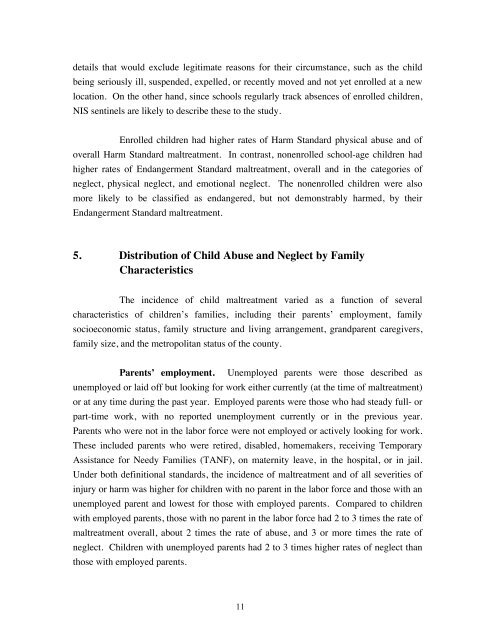National Incidence Study of Child Abuse and ... - Children's Central
National Incidence Study of Child Abuse and ... - Children's Central
National Incidence Study of Child Abuse and ... - Children's Central
- No tags were found...
You also want an ePaper? Increase the reach of your titles
YUMPU automatically turns print PDFs into web optimized ePapers that Google loves.
details that would exclude legitimate reasons for their circumstance, such as the childbeing seriously ill, suspended, expelled, or recently moved <strong>and</strong> not yet enrolled at a newlocation. On the other h<strong>and</strong>, since schools regularly track absences <strong>of</strong> enrolled children,NIS sentinels are likely to describe these to the study.Enrolled children had higher rates <strong>of</strong> Harm St<strong>and</strong>ard physical abuse <strong>and</strong> <strong>of</strong>overall Harm St<strong>and</strong>ard maltreatment. In contrast, nonenrolled school-age children hadhigher rates <strong>of</strong> Endangerment St<strong>and</strong>ard maltreatment, overall <strong>and</strong> in the categories <strong>of</strong>neglect, physical neglect, <strong>and</strong> emotional neglect. The nonenrolled children were alsomore likely to be classified as endangered, but not demonstrably harmed, by theirEndangerment St<strong>and</strong>ard maltreatment.5. Distribution <strong>of</strong> <strong>Child</strong> <strong>Abuse</strong> <strong>and</strong> Neglect by FamilyCharacteristicsThe incidence <strong>of</strong> child maltreatment varied as a function <strong>of</strong> severalcharacteristics <strong>of</strong> children’s families, including their parents’ employment, familysocioeconomic status, family structure <strong>and</strong> living arrangement, gr<strong>and</strong>parent caregivers,family size, <strong>and</strong> the metropolitan status <strong>of</strong> the county.Parents’ employment. Unemployed parents were those described asunemployed or laid <strong>of</strong>f but looking for work either currently (at the time <strong>of</strong> maltreatment)or at any time during the past year. Employed parents were those who had steady full- orpart-time work, with no reported unemployment currently or in the previous year.Parents who were not in the labor force were not employed or actively looking for work.These included parents who were retired, disabled, homemakers, receiving TemporaryAssistance for Needy Families (TANF), on maternity leave, in the hospital, or in jail.Under both definitional st<strong>and</strong>ards, the incidence <strong>of</strong> maltreatment <strong>and</strong> <strong>of</strong> all severities <strong>of</strong>injury or harm was higher for children with no parent in the labor force <strong>and</strong> those with anunemployed parent <strong>and</strong> lowest for those with employed parents. Compared to childrenwith employed parents, those with no parent in the labor force had 2 to 3 times the rate <strong>of</strong>maltreatment overall, about 2 times the rate <strong>of</strong> abuse, <strong>and</strong> 3 or more times the rate <strong>of</strong>neglect. <strong>Child</strong>ren with unemployed parents had 2 to 3 times higher rates <strong>of</strong> neglect thanthose with employed parents.11
















